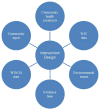The Healthy Children, Strong Families intervention: design and community participation
- PMID: 22956296
- PMCID: PMC3904366
- DOI: 10.1007/s10935-012-0275-y
The Healthy Children, Strong Families intervention: design and community participation
Abstract
Healthy Children, Strong Families (HCSF) is a 2-year, community-driven, family-based randomized controlled trial of a healthy lifestyles intervention conducted in partnership with four Wisconsin American Indian tribes. HCSF is composed of 1 year of targeted home visits to deliver nutritional and physical activity curricula. During Year 1, trained community mentors work with 2-5-year-old American Indian children and their primary caregivers to promote goal-based behavior change. During Year 2, intervention families receive monthly newsletters and attend monthly group meetings to participate in activities designed to reinforce and sustain changes made in Year 1. Control families receive only curricula materials during Year 1 and monthly newsletters during Year 2. Each of the two arms of the study comprises 60 families. Primary outcomes are decreased child body mass index (BMI) z-score and decreased primary caregiver BMI. Secondary outcomes include: increased fruit/vegetable consumption, decreased TV viewing, increased physical activity, decreased soda/sweetened drink consumption, improved primary caregiver biochemical indices, and increased primary caregiver self-efficacy to adopt healthy behaviors. Using community-based participatory research and our history of university-tribal partnerships, the community and academic researchers jointly designed this randomized trial. This article describes the study design and data collection strategies, including outcome measures, with emphasis on the communities' input in all aspects of the research.
Figures
References
-
- Adams AK, Harvey H, Brown D. Constructs of health and environment inform child obesity prevention in American Indian communities. Obesity. 2008;16:311–317. - PubMed
-
- Adams AK, Miller-Korth N, Brown D. Learning to work together: Developing academic and community research partnerships. Wisconsin Medical Journal. 2004;103:15–19. - PubMed
-
- Adams AK, Quinn RA, Prince RJ. Low recognition of childhood overweight and disease risk among Native-American caregivers. Obesity Research. 2005;13:146–152. - PubMed
-
- Armitage CJ. Can the theory of planned behavior predict the maintenance of physical activity? Health Psychology. 2005;24:235–245. - PubMed
Publication types
MeSH terms
Grants and funding
LinkOut - more resources
Full Text Sources
Medical



